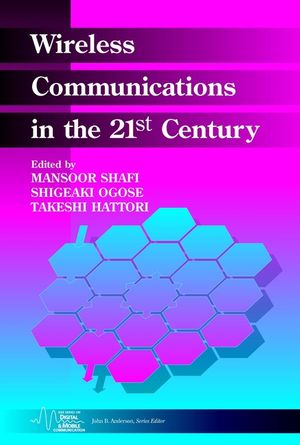Wireless Communications in the 21st CenturyISBN: 978-0-471-15041-1
Hardcover
456 pages
March 2002, Wiley-IEEE Press
 This is a Print-on-Demand title. It will be printed specifically to fill your order. Please allow an additional 10-15 days delivery time. The book is not returnable.
|
||||||
1 Introduction (Mansoor Shaft, Shigeaki Ogose, and Keith Buttenvorth).
1.1 History of Mobile Radio Communications.
1.2 Telecommunication Needs for the 21st Century.
1.3 Data Rate Road Map to 3G.
1.4 Mobile Networks of Tomorrow.
1.5 4G Mobile Systems.
1.6 Handsets.
1.7 Mobility Management in an IP World.
1.8 Mobile IP.
1.9 Spectrum for Mobile Systems.
1.10 Organization of this Book.
1.11 Summary.
Acronyms.
References.
PART 1: Visions of Wireless Communications Applications in the 21st Century.
2 Vision of Wireless Communications in the 21st Century (Raymond Steele).
2.1 Introduction.
2.2 Current Scene in Wireless Communications.
2.3 3G Scene for the Beginning of the 21st Century.
2.4 Post-3G Systems.
2.5 Global Family of Ad Hoc Networks.
2.6 Peering Through the Future Haze.
References.
3 Wireless Migration to Packet Network: U.S. Viewpoint (Chung Liu and Wayne Strom).
3.1 Future Wireless Network Vision.
3.2 Future Wireless Network Architecture.
3.3 Wireless Packet Network Evolution.
3.4 Migration of Wireless Radio Access to Packet Data Network (Including M-IP and GPRS).
3.5 Wireless Packet Network.
3.6 Summary.
References.
4 Vision of Wireless Communications Applications in the 21st Century: A View from Japan (Mitsutoshi Hatori).
4.1 Introduction 57
4.2 Current Wireless Communications Systems.
4.3 Third-Generation Systems.
4.4 Fourth-Generation Systems.
4.5 Other Future Systems.
4.6 Summary.
References.
PART 2: Developments in International Standards.
5 Developments in International Standards (Jane Brownley, Fran O 'Brien, Maria Palamara, Derek Richards, and Lynne Sinclair).
5.1 Overview.
5.2 ITU's IMT-2000 Standardization Efforts.
5.3 3G Standardization Consortia.
5.4 Evolving Radio Standards.
5.5 Evolving Network Standards.
5.6 Related Standardization Efforts.
5.7 Summary.
References.
6 Standardization on Broadband Wireless Access: Wireless ATM and IP (Masahiro Umehira).
6.1 Introduction.
6.2 Standardization Efforts Related to Broadband Wireless Access.
6.3 Standardization on Radio Access Layer.
6.4 Standardization on Mobile ATM.
6.5 Conclusions.
References.
PART 3: Propagation Issues.
7 Multipath Effects Observed for the Radio Channel (Hemy L. Bertoni).
7.1 Introduction.
7.2 Measurement of Multipath Arrivals.
7.3 Multipath Phenomena for Narrowband Excitation.
7.4 Multipath Phenomena for Broadband Excitation.
7.5 Angular Spread for Space-Time Signal Processing.
7.6 Summary.
References.
8 Indoor Propagation Modeling (Homayoun Hashemi).
8.1 Introduction.
8.2 Types of Variations in the Channel.
8.3 Wideband Channel.
8.4 Large-Scale Path Losses.
8.5 rms Delay Spread.
8.6 Spatial Variations of the Channel.
8.7 Temporal Variations of the Channel.
8.8 Comparison Between Indoor and Outdoor Radio Channels.
8.9 Indoor Infrared Channel.
8.10 Conclusions.
References.
9 Propagation Loss Prediction Models (Masaharu Hata).
9.1 Introduction.
9.2 Empirical Models.
9.3 Analytical Models.
9.4 Deterministic Methods.
9.5 Summary.
References.
10 Path-Loss Measurements for Wireless Mobile Systems (Dongsoo Ear and Howard H. Xia).
10.1 Overview.
10.2 Macrocellular Measurements.
10.3 Microcellular Measurements.
10.4 Indoor Measurements.
10.5 Summary.
References.
Part 4: Technologies.
11 Coding and Modulation for Power-Constrained Wireless Channels (Ezio Biglieri, Giuseppe Caire, and Giorgio Taricco).
11.1 Introduction.
11.2 Designing a C/M Scheme: The Gaussian Channel Perspective.
11.3 Wireless Channel: A New Perspective.
11.4 Flat Independent Fading Channel.
11.5 Block-Fading Channel.
11.6 Interference-Limited Channel.
11.7 Conclusions.
References.
12 Modulation and Demodulation Techniques for Wireless Communication Systems (Seiichi Sampei).
12.1 Introduction.
12.2 Outline of Modulation and Demodulation Techniques.
12.3 GMSK.
12.4 QPSK.
12.5 Π/4-QPSK.
12.6 M-ary QAM.
12.7 Pilot Signal-Aided Fading Compensation Techniques.
12.8 Orthogonal Frequency Division Multiplexing.
12.9 Adaptive Modulation.
12.10 Summary.
References.
13 Fundamentals of Multiple Access Techniques (Fumiyuki Adachi).
13.1 Introduction.
13.2 Multiple Access Techniques.
13.3 Demand-Assign-Based Multiple Access.
13.4 Random Multiple Access.
13.5 Summary.
References.
14 Spatial-Temporal Signal Processing for Broadband Wireless Systems (David Falconer).
14.1 Introduction: Motivation and Configurations for Space-Time Processing.
14.2 Channel Models for Multielement Arrays.
14.3 Receiver Space-Time Processing.
14.4 Recent Space-Time Wireless Communication Architectures.
14.5 Adaptation Issues.
14.6 Transmitter Space-Time Processing.
14.7 Conclusions and Future Applications.
References.
15 Interference Cancellation and Multiuser Detection (Ryuji Kohno).
15.1 Introduction.
15.2 CDMA System Model.
15.3 Multiuser Detection for CDMA.
15.4 Co-Channel Interference Cancellation for DS/CDMA.
15.5 Co-Channel Interference Cancellation for FH/CDMA.
15.6 Concluding Remarks.
References.
PART 5: Wireless Systems and Applications.
16 EDGE: Enhanced Data Rates for GSM and TDMA/136 Evolution (Stefan Jäverbring).
16.1 Introduction.
16.2 Background.
16.3 Physical Layer.
16.4 Link Layer.
16.5 EGPRS Performance.
16.6 Conclusions.
References
17 Continuing Evolution of CDMA into New and Improved Services (Andrew J. Viterbi).
17.1 Commercial CDMA: A Brief Condensed History.
17.2 System Features of Code Division Multiple Access.
17.3 Early CDMA Evolution for Data Services.
17.4 Improvement and Evolution to CDMA 2000.
17.5 Generational Evolution and Emphasis on Wider Band widths.
17.6 Alternate Implementation of Wider Band CDMA.
17.7 Reexamining the Goal: Wireless High-Speed Data Transmission.
17.8 CDMA/HDR for High-Speed Wireless Internet Access.
17.9 Implementation of CDMA/HDR.
17.10 Summary and Concluding Remarks.
References.
18 WCDMA Radio Access Technology for Third-Generation Mobile Communication (Erik Dahlman, Fredrik Ovesjo, Per Beming, Christiaan Roobol, Magnus Persson, Jens Knutsson, and Joakim Sorelius).
18.1 Introduction.
18.2 Background to WCDMA.
18.3 UMTS/IMT-2000 System Overview.
18.4 WCDMA Radio Protocol Operation.
18.5 WCDMA Physical Layer.
18.6 WCDMA Radio Resource Management.
18.7 Performance-Enhancing Technologies.
References.
19 New Systems for Personal Communications via Satellite (J. V Evans).
19.1 Introduction.
19.2 Mobile Satellite Services.
19.3 Proposed Global Satellite Phone System Designs.
19.4 Data and Multimedia Services.
19.5 Concluding Remarks.
PART 6: Wireless ATM Networks.
20 Wireless ATM Networks (D. Raychaudhuri, P. Narasimhan, B. Rajagopalan, and D. Reininger).
20.1 Introduction.
20.2 Wireless ATM Architecture.
20.3 WATM Radio Access Layer.
20.4 Mobile ATM Network.
20.5 QoS Control in Wireless ATM.
20.6 Concluding Remarks.
References.
Index.
About the Editors.



